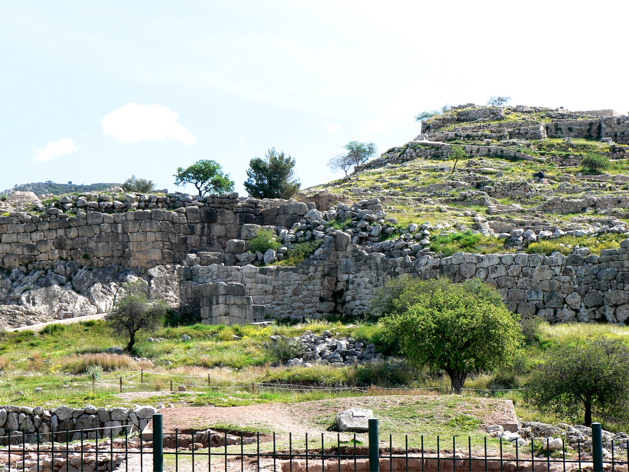<--Previous Up Next-->

P1060908.JPG
Mycenea, Peloponesia, Greece: the palace of Agamemnon in Mycenea
Mycenae
In 1874 Henry Schleimann discovered the ancient citadel of Mycenae, which stands on a low hill wedged between the lofty peak of Mounts Zara and Profitis Ilias. From here, in the palace which crowns the hill, Agamemnon and his descendants were rulers of all they surveyed. They controlled an empire of mini-states in the Argolid of which Argos and Tiryns were the most important in the Peloponnese.
The Mycenaeans were an Indo-European people who began to arrive in Greece around 2,100 BC. By around 1,600 BC they had created a world of small, sophisticated Bronze Age settlements centered around large palaces which were ringed by crude but imposing walls of massive stone blocks.
The best known of these is Mycenae itself, but there are other palace sites at Tiryns and Pylos. After the fall of Minoan civilization in Crete, the Mycenaeans became the main power in the region. Many inscriptions in Linear B, the earliest known Greek writing, have been found at Knossos (on Crete) as well as on the Greek mainland. The Mycenaean civilization crumbled quite suddenly around 1,200 BC, for unknown reasons. This was followed by a Dark Age which lasted almost two centuries.
Excavations show several generations of squatters using the sites of the Mycenaean palaces during that time, before the iron-using Dorians — speaking another dialect of Greek — began to trickle in and settle much of the Greek world around 1,050 BC. By the time they settled in the former Mycenaean heartlands. Mycenae and its kings were shadowy legends, and it came to be believed that the massive walls of their palaces had been built not by men but by the one-eyed giant called Cyclops.
The citadel can be entered from the north-west through the Lions Gate. The relief triangle above the joist carries the oldest example of monumental sculpture. Two lions, whose heads stand facing each other, their paws resting on a high pedestal representing an altar above which stands a pillar ending in a uniquely shaped capital and abacus. The gate was closed by a double wooden door sheathed in bronze. After passing through the Lions Gate one can see the six royal graves, encircled by a row of stone slabs placed upright in the ground. The dead were buried with a selection of personal belongings such as gold face masks, gold cups, jewelry, bronze swords and daggers with gold inlay decoration.
The cobbled ramp outside the grave area leads to the palace and the upper part of the citadel. A short distance away from the main site is the treasury of Atreus, often referred to as the Tomb of Agamemnon. The tomb is beehive shaped with a smaller inner chamber.
